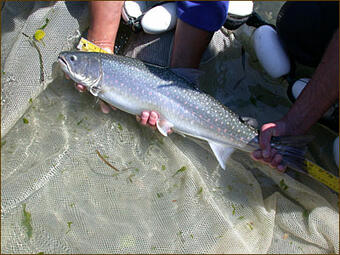Bull Trout (Salvelinus confluentus) - KFFS
Species Studied - Bull Trout (Salvelinus confluentus)

Bull trout (Salvelinus confluentus) are members of the salmonid family (salmon and trout) that are native to the northwest United States and western Canada. Compared to most other salmonids, bull trout are relatively long-lived (over 10 years) and have rather specific habitat requirements that restrict their distribution and abundance. Bull trout prefer stream habitats with clean, clear, and especially cold water, stable stream channels, and abundant and diverse overhead cover such as woody debris. Bull trout exhibit a number of life history strategies. Resident forms spend their entire lives in relatively small streams. Fluvial forms stay in streams throughout their lives but adults migrate upstream into smaller tributaries for spawning. Adfluvial forms spawn and rear in streams, but adults spend their non-spawning lives in downstream lakes or reservoirs. Finally, some populations include anadromous individuals that rear in the ocean and return to streams to spawn. Bull trout are strongly piscivorous where fish prey are available and migratory forms can grow very large (upwards of 15 pounds). Migratory forms of bull trout require extensive, unfragmented stream networks. Spawning adults migrate upstream beginning in late summer, sometimes covering great distances, and most spawning occurs in September and October.
Bull trout were listed as federally threatened under the Endangered Species Act in 1999, including all populations in the coterminous United States (Washington, Oregon, Idaho, Montana, and Nevada). Bull trout are primarily threatened by habitat degradation and fragmentation, blockage of migratory corridors, poor water quality, past fisheries management, and the introduction of nonnative species such as brown and brook trout. Bull trout in the Klamath Basin are evolutionarily and genetically distinct from other bull trout populations and are physically isolated from other populations near the southernmost extent of the current species distribution. The Klamath Basin populations comprise the Klamath Recovery Unit for management purposes under the Endangered Species Act. Bull trout were once widespread in the Basin, but their distribution has been greatly reduced by stream channelization, agricultural water diversions, and removal of riparian vegetation that has increased water temperatures, reduced water quantity and quality, and increased sedimentation. In addition, competition and hybridization with brook and brown trout in most streams pose significant

threats. The remaining nine populations of bull trout in the Klamath Basin represent about 20% of the historic range of the species and these populations are small, fragmented, and at risk of extirpation, particularly considering expected changes in future climate.
USGS partners with the U.S. Fish and Wildlife Service on various bull trout research projects in the Klamath Basin. Research uses passive integrated technology to monitor the movement of bull trout and other co-occurring trout to understand movement, barriers to movement, and habitat use. Data are used to determine how natural and man-made structures hinder bull trout movement. Other research includes investigation of how large woody debris effects the survival of bull trout in the presence of non-native trout.
Species Studied - Bull Trout (Salvelinus confluentus)

Bull trout (Salvelinus confluentus) are members of the salmonid family (salmon and trout) that are native to the northwest United States and western Canada. Compared to most other salmonids, bull trout are relatively long-lived (over 10 years) and have rather specific habitat requirements that restrict their distribution and abundance. Bull trout prefer stream habitats with clean, clear, and especially cold water, stable stream channels, and abundant and diverse overhead cover such as woody debris. Bull trout exhibit a number of life history strategies. Resident forms spend their entire lives in relatively small streams. Fluvial forms stay in streams throughout their lives but adults migrate upstream into smaller tributaries for spawning. Adfluvial forms spawn and rear in streams, but adults spend their non-spawning lives in downstream lakes or reservoirs. Finally, some populations include anadromous individuals that rear in the ocean and return to streams to spawn. Bull trout are strongly piscivorous where fish prey are available and migratory forms can grow very large (upwards of 15 pounds). Migratory forms of bull trout require extensive, unfragmented stream networks. Spawning adults migrate upstream beginning in late summer, sometimes covering great distances, and most spawning occurs in September and October.
Bull trout were listed as federally threatened under the Endangered Species Act in 1999, including all populations in the coterminous United States (Washington, Oregon, Idaho, Montana, and Nevada). Bull trout are primarily threatened by habitat degradation and fragmentation, blockage of migratory corridors, poor water quality, past fisheries management, and the introduction of nonnative species such as brown and brook trout. Bull trout in the Klamath Basin are evolutionarily and genetically distinct from other bull trout populations and are physically isolated from other populations near the southernmost extent of the current species distribution. The Klamath Basin populations comprise the Klamath Recovery Unit for management purposes under the Endangered Species Act. Bull trout were once widespread in the Basin, but their distribution has been greatly reduced by stream channelization, agricultural water diversions, and removal of riparian vegetation that has increased water temperatures, reduced water quantity and quality, and increased sedimentation. In addition, competition and hybridization with brook and brown trout in most streams pose significant

threats. The remaining nine populations of bull trout in the Klamath Basin represent about 20% of the historic range of the species and these populations are small, fragmented, and at risk of extirpation, particularly considering expected changes in future climate.
USGS partners with the U.S. Fish and Wildlife Service on various bull trout research projects in the Klamath Basin. Research uses passive integrated technology to monitor the movement of bull trout and other co-occurring trout to understand movement, barriers to movement, and habitat use. Data are used to determine how natural and man-made structures hinder bull trout movement. Other research includes investigation of how large woody debris effects the survival of bull trout in the presence of non-native trout.

